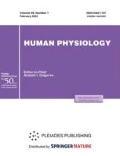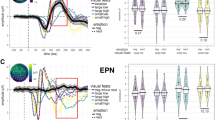Abstract
The effect of nonsemantic context on the perception of simple nonverbal visual stimuli has been studied in ten healthy volunteers by the event-related potential (ERP) method. The nonsemantic context was specified by the formation of a memory trace of a test visual stimulus via its repeated presentation without any instruction except gaze fixation. Then, this stimulus randomly alternated with control stimuli that did not form memory traces before their presentation. It has been found that an ERP in the interval 260–340 ms after presentation of a simple nonverbal stimulus significantly differs from the control ERPs. The results suggest that some stages of the processing of visual stimuli may be modified by nonsemantic context.
Similar content being viewed by others

References
Forster, K.I., The Pros and Cons of Masked Priming, J. Psycholinguistic Research, 1998, vol. 27, p. 203.
Fischer, R., Schubert, T., and Liepelt, R., Accessory Stimuli Modulate Effects of Nonconscious Priming, Percept. Psychophys., 2007, vol. 69, no. 1, p. 9.
Tulving, E. and Schacter, D.L., Priming and Human Memory Systems, Science, 1990, vol. 247, p. 301.
Eddy, M., Schmid, A., and Holcomb, P.J., Masked Repetition Priming and Event-Related Brain Potentials: A New Approach for Tracking the Time-Course of Object Perception, Psychophysiology, 2006, vol. 43, no. 6, p. 564.
Marcel, A.J., Conscious and Unconscious Perception: Experiments on Visual Masking and Word Recognition, Cogn. Psychol., 1983, vol. 15, no. 2, p. 197.
McCarthy, G. and Nobre, A.C., Modulation of Semantic Processing by Spatial Selective Attention, EEG Clin. Neurophysiol., 1993, vol. 88, no. 3, p. 210.
Holcomb, P.J., Reder, L., Misra, M., and Grainger, J., The Effects of Prime Visibility on ERP Measures of Masked Priming, Cogn. Brain Res., 2005, vol. 24, p. 155.
Squire, L.R., Shimamura, A.P., and Graf, P., Independence of Recognition Memory and Priming Effects: a Nemopsychological Analysis, J. Exp. Psychol. Learn. Mem. Cogn, 1985, vol. 11, p. 37.
Schacter, D.L., Cooper, L.A., and Delaney, S.M., Implicit Memory for Possible and Impossible Objects: Constraints on the Construction of Structural Descriptions, J. Exp. Psychol. Learn. Mem. Cogn, 1991, vol. 17, p. 3.
Zhang, X.L., Begleiter, H., Porjesz, B., and Litkeb, A., Visual Object Priming Differs from Visual Word Priming: An ERP Study, EEG Clin. Neurophysiol., 1997, vol. 102, no. 3, p. 200.
Osterberg, G., Topography of the Layer of Rods and Cones in the Human Retina, Acta Ophthalm., 1935, no. Suppl. 6, p. 1.
Curcio, C.A., Sloan, K.R., Packer, O., et al., Distribution of Cones in Human and Monkey Retina: Individual Variability and Radial Asymmetry, Science, 1987, vol. 236, p. 579.
Pazo-Alvarez, P., Cadaveira, F., and Amenedo, E., MMN in the Visual Modality: a Review, Biol. Psychol., 2003, vol. 63, no. 3, p. 199.
Patel, S.H. and Azzam, P.N., Characterization of N200 and P300: Selected Studies of the Event-Related Potential, Int. J. Med. Sci., 2005, vol. 2, p. 147.
Kotchoubey, B., Event-Related Potentials, Cognition, and Behavior: a Biological Approach, Neurosci. Biobehav. Rev., 2006, vol. 30, no. 1, p. 42.
Luck, S., An Introduction to the Event-Related Potential Technique, Cambridge: MIT-press, 2005.
Johnson, J.S. and Olshausen, B.A., Timecourse of Neural Signatures of Object Recognition, J. Vision, 2003, vol. 3, p. 499.
Mecklinger, A. and Meinshausen, R.M., Recognition Memory for Object Form and Object Location: An Event-Related Potential Study, Mem. Cognit., 1998, vol. 26, p. 1068.
Verleger, R., Jaskowski, P., and Wauschkuhn, B., Suspense and Surprise: on the Relationship Between Expectancies and P3, Psychophysiology, 1994, vol. 31, no. 4, p. 359.
Scherg, M. and Picton, T.W., Separation and Identification of Event-Related Potential Components by Brain Electric Source Analysis, EEG Clin. Neurophysiol., 1991, vol. 42,suppl., p. 24.
Yamaguchi, S. and Knight, R.T., Anterior and Posterior Association Cortex Contributions To the Somatosensory P300, J. Neurosci., 1991, vol. 11, p. 2039.
Simmons, R.F., Graham, F.K., Miles, M.A., and Chen, X., On the Relationship of the P3a and the Novelty P3, Biol. Psychol., 2001, vol. 56, p. 207.
Curran, T. and Dien, J., Differentiating Amodal Amiliarity from Modality-Specific ÏEmory Processes: An ERP Study, Psychophysiology, 2003, vol. 40, no. 6, p. 979.
Friedman, D., Cognitive Event-Related Potential Components During Continuous Recognition Memory for Pictures, Psychophysiology, 1990, vol. 27, no. 2, p. 136.
Begleiter, H., Porjesz, B., and Wang, W., A Neurophysiologic Correlate of Visual Short-Term Memory in Humans, EEG Clin. Neurophysiol., 1993, vol. 87, p. 46.
Curran, T., The Electrophysiology of Incidental and Intentional Retrieval: ERP Old / New Effects in Lexical Decision and Recognition Memory, Neuropsychologia, 1999, vol. 37, p. 771.
Curran, T., Brain Potentials of Recollection and Familiarity, Mem. Cognit., 2000, vol. 20, p. 923.
Allan, K., Wilding, E.L., and Rugg, M.D., Electrophysiological Evidence for Dissociable Processes Contributing To Recollection, Acta Psychol., 1998, vol. 98, p. 231.
Rugg, M.D., Mark, R.E., Walla, P., et al., Dissociation of the Neural Correlates of Implicit and Explicit Memory, Nature, 1998, vol. 392, p. 595.
Electrophysiology of Mind: Event-Related Brain Potentials and Cognition, Rugg, M.D. and Coles, M.G.H, Eds., New York: Oxford Univ. Press, 1995.
Currana, T. and Clearyb, A.M., Using ERPs To Dissociate Recollection from Familiarity in Picture Recognition, Cogn. Brain Res., 2003, vol. 15, p. 191.
Author information
Authors and Affiliations
Additional information
Original Russian Text © E.V. Levichkina, A.Ya. Kaplan, 2009, published in Fiziologiya Cheloveka, 2009, Vol. 35, No. 2, pp. 27–32.
Rights and permissions
About this article
Cite this article
Levichkina, E.V., Kaplan, A.Y. Unconscious context control of visual perception of simple stimuli: A study using evoked potentials. Hum Physiol 35, 152–156 (2009). https://doi.org/10.1134/S0362119709020030
Received:
Published:
Issue Date:
DOI: https://doi.org/10.1134/S0362119709020030



